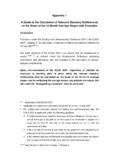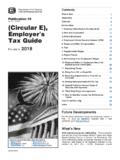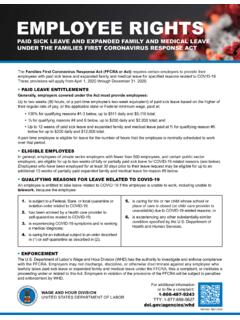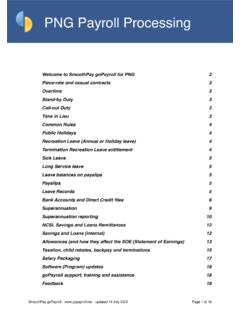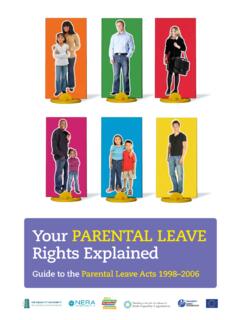Transcription of Holiday entitlement: guide to calculating statutory ...
1 November 2019 Holiday ENTITLEMENT guide on calculating statutory Holiday Entitlement for Workers Crown copyright 2019 This publication is licensed under the terms of the Open Government Licence except where otherwise stated. To view this licence, visit or write to the Information Policy Team, The National Archives, Kew, London TW9 4DU, or email: Where we have identified any third-party copyright information you will need to obtain permission from the copyright holders concerned. Any enquiries regarding this publication should be sent to us at: 3 Contents Introduction _____ 4 Using this Guidance _____ 5 Definitions _____ 6 1 calculating leave for a Full leave Year _____ 9 Days per Week _____ 9 Hours per Week / Compressed Hours _____ 9 Casual, Irregular or Annualized Hours _____ 10 Shift Workers _____ 10 2 calculating leave for Somebody Starting Part-Way Through a leave Year __ 12 Days per Week _____ 13 Hours per Week / Compressed Hours _____ 14 Casual, Irregular or Annualized Hours _____ 15 Shift Workers _____ 16 3.
2 calculating leave for Somebody Leaving Part-Way through a leave Year ____ 17 Days Worked per Week _____ 17 Hours Worked per Week _____ 17 Casual, Irregular or Annualized Hours _____ 18 Shift Workers _____ 19 4. calculating leave for Somebody Starting & Leaving Part-Way Through a leave Year _____ 21 Days Worked per Week _____ 21 Hours Worked per Week _____ 22 Casual, Irregular or Annualized Hours _____ 23 Shift Workers _____ 23 Holiday Entitlement Guidance 4 Introduction This document provides guidance on how statutory Holiday entitlement may be calculated for workers on different types of contract. It has been designed as a practical guide for employers and workers to accompany the Holiday entitlement calculator.
3 Holiday legislation grants almost all workers weeks paid annual leave a year. This includes agency workers, workers with irregular hours and workers on zero-hours contracts. This entitlement is set out in the Working Time Regulations 19981. Guidance on how to calculate the pay that a worker is entitled for their statutory leave entitlement is available online2. A worker continues to accrue Holiday entitlement while they are on sick leave , maternity leave , paternity leave , parental leave , shared parental leave and adoption leave (collectively known as statutory leave ). A worker may request Holiday at the same time they are on sick leave (but cannot be required to take Holiday while on sick leave ).
4 Please note: This guidance is focussed on the legal minimum entitlement of weeks paid Holiday . Many individuals will have contracts entitling them to additional paid Holiday beyond the statutory minimum. Individual contracts should be checked first. All references to worker refer to all individuals whose employment status is either as a worker or an employee , meaning they are entitled to paid Holiday . For further information on employment status and definitions please visit This guidance refers solely to the Holiday entitlement aspect of paid annual leave . The leave calculated using this guidance must be paid to qualify as part of the statutory weeks.
5 This guidance makes references to leap years and leap days. A leap year is a calendar year containing an additional day added to keep the calendar year synchronized with the astronomical or seasonal year. The additional day, referred to in this guidance as a leap day , is the 29th February. The next leap year is 2020 and the next leap day is 29th February 2020. This guidance should be used to calculate the statutory minimum leave entitlement. As such, the entitlement calculated must not be rounded down (and in certain circumstances must be rounded up). Throughout this guidance, exact figures are used in calculations. The final figure may therefore not precisely match the calculation written before it.
6 This approach is taken to mitigate rounding errors; the figures in the written calculation are rounded, but the figures in the actual calculation are not. Answers are rounded up to the same accuracy as in the statutory Holiday entitlement calculator available on 1 Working Time Regulations 1998: regulations 13, 13A, 15A and 16 (subject to some limited exceptions, for example for services such as the armed forces or the police in certain circumstances, see regulation 18(2)(a)). There is also separate legislation for particular sectors or occupations, such as for agricultural workers and seafarers (for example, see regulation 18 of the Working Time Regulations). 2 Holiday Entitlement Guidance 5 Using this Guidance Before reading this guidance please check the inf ormation on on the basics of how Holiday entitlement should be calculated as this guidance is designed to complement what is available.
7 This guidance contains additional detail and is designed to complement the guidance already available on It should be used to help improve understanding of how to calculate statutory Holiday entitlement. However, it does not and cannot provide definitive answers to individual queries. It is not intended to be relied upon in any specific context or as a substitute for seeking advice (legal or otherwise) on a specific circumstance, as each case may be different. Whether you are a worker or employer, if you are unsure about any aspect of Holiday pay entitlement you can contact Acas: Telephone: 0300 123 11 00 Textphone: 18001 0300 123 1100 Holiday Entitlement Guidance 6 Definitions This guidance is split into four sections, with each section covering Holiday entitlement calculations a different type of working arrangement.
8 These are defined below to provide clarity for users. Definitions of other common terms are also provided. Section 1 - Days Worked per Week Individuals with a fixed working pattern involving a set number of days of equal length. leave can be calculated in days of fixed length. This option can also relate to those who work a pattern of days over a fortnight ( a nine-day fortnight), as they will have a fixed average working week (in this case days a week makes up a nine-day fortnight). Example working patterns: 5 days a week, with each day being 8 hours long 3 days a week, with each day being 6 hours long 9 days every two weeks, with each day being hours long Section 2 - Hours Worked per Week / Compressed Hours Individuals contracted to work a set number of hours in a period of time, over days of different lengths.
9 This can be working over a week, a fortnight, or another working pattern. For some workers who work a fixed number of hours but not the same number of hours each day, or who work part-time, it may be more appropriate to calculate their Holiday entitlement in hours. The same may be the case for those who work compressed hours (full-time hours over fewer days). Example working patterns: 25 hours a week, over 4 days. Monday and Wednesday being 8 hours long, Tuesday and Thursday being hours long 40 hours a week, over 5 days. Monday, Wednesday and Thursday being 10 hours long, Tuesday and Friday being 5 hours long Section 3 - Casual, Irregular or Annualized Hours Individuals who do not have guaranteed hours or who do not have a regular working pattern.
10 As there is no fixed work pattern on which to base annual leave , the entitlement should instead generally be kept in weeks. For workers who do not have regular hours, or who are on an annualised hours contract, it may be appropriate to grant paid annual leave to be taken during periods when no work is performed. This depends on the particular circumstances, and employers must ensure workers are able to take their full leave entitlement. This may also include workers on casual employment contracts. Example working pattern: Holiday Entitlement Guidance 7 A worker on a zero-hours contract who only works when they are offered work by their employer. They are not obligated to accept this work, and have no regular hours.











